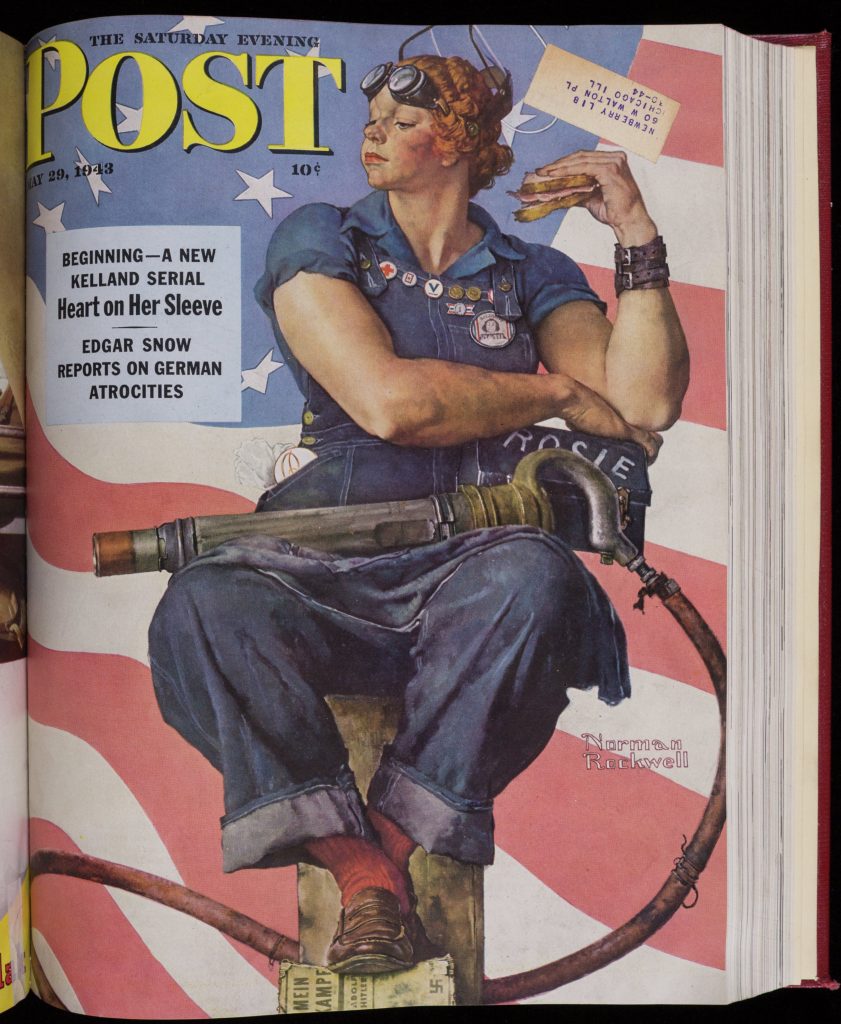Curriculum Connections: Visual Literacy, Women’s History, World War II
This activity is a way to provide a lesson on visual literacy within a history curriculum as well as an introduction to or exploration of propaganda.
Materials – Available for Download in the Downloads Tab:
- A copy of the “World War II and U.S. Visual Culture” activity
Display the image. Give students time to generate and answer questions about it and write notes. Use the background material at the end of this activity whenever you think it will encourage students to ask more questions and think more about how to engage with the poster.
Click on the image for a high-resolution version that can be displayed for your class.

Looking Closely Questions
Before giving students the caption:
Have students examine the image for more than a minute.
- What do you see?
- Describe the person you see in the picture.
- List some of the objects and details in the picture.
- What questions do you have about this illustration or the person it depicts?
Use the background material at the end of this activity whenever you think it will encourage students to ask more questions and think more about how to engage with the image.
Generating Discussion
If students haven’t been able to generate their own questions, ask:
- What is the woman in the picture wearing?
- What she is holding, and what the things are around her?
- Who do you think the person is in the picture? What kind of work does she do?
- What can also you tell about her age, physical health, social class, and even her diet?
Follow-Up Questions
Provide students with all or part of the caption.
Norman Rockwell, “Rosie the Riveter,” Saturday Evening Post, May 29, 1943
You may want to review the Skills Lesson: Reading a Caption with students. Explain or make sure students understand what “riveting” is. Then ask:
- What was occurring in American history at the time of this publication?
- How could riveting help in the war effort?
- Why would it be different and interesting to see a woman doing this kind of work?
More Extensive Analysis Questions
- Both men and women bought and sold magazines. How might a magazine with an illustration like this on its cover have appeared to a female audience?
- How does showing untraditional “fighters” like “Rosie” help win the war?
- Although this picture looks realistic, “Rosie the Riveter” was a fictional character that was originally created as media propaganda to encourage women to work in wartime factories. How might actual women factory workers have been different from the person depicted here?
Background
World War II engaged just about everyone in the United States in some way. Newspapers and magazines were full of stories about the war—what was happening overseas and how the war was being supported on the “home front.”
Pictorial magazines, which contained a mixture of news, human-interest stories, advertising, and pictures, were extremely popular during this period. The Saturday Evening Post was one of the most popular. The artist Norman Rockwell was a regular contributor to the magazine, and his pictures came to represent an “American ideal.”
Rockwell was a prolific illustrator. His first cover for the Post appeared in 1916 when he was only twenty-two. Over the next forty-seven years he illustrated a total of 322 covers. Rockwell always had actual people pose for his pictures. The subjects of most of his illustrations were taken from middle-class small-town life and were often light and humorous. Though his illustrations were loved by the general public, Rockwell was not taken seriously as an artist by most critics.
Extension Activity 1
Have students research and then analyze other magazine covers and advertisements from the 1930s and 1940s that show women.
Have students consider how the women were represented. Why they were being shown that way? Were they selling a product? Helping the war effort? Were these truthful representations? And/or were they stereotypes?
Extension Activity 2
Have students research or review material covered in class about the role of women in factories during World War II. Ask:
- What have you learned about the kind of work they did?
- What happened to these workers when male workers returned from the war?
Extension Activity 3
Show students a variety of images (photographs and art) that show “Rosie the Riveter” or women doing factory work during the war. How are these images different from Rockwell’s Rosie? How are they different from each other?
The Wikipedia article “Rosie the Riveter” has a good selection.
For example:

Additional Resources
- Collection Essay “World War II and U.S. Visual Culture.”
- Powers of Persuasion, an exhibit at the National Archives on World War II posters.
- “Norman Rockwell: A Brief Biography,” Norman Rockwell Museum
- “Norman Rockwell: American Illustrator,” Encyclopedia Britannica
Download the following materials below:
- A copy of the “World War II and U.S. Visual Culture” activity



